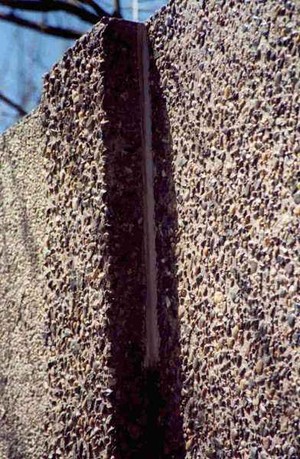Proper design of noise barrier systems requires the consideration of a variety of structurally related factors. This section is not intended to provide either a standard or a recommended process for the structural design of noise barriers. Rather, its goal is to identify structural issues which should be addressed and considered in the design of barrier systems. Specific application and interpretation of appropriate structural criteria is the responsibility of the respective responsible organization in charge of designing and constructing the barrier system.
All materials used in the construction of noise barriers expand and contract with temperature and moisture variation. Such expansion and contraction must be appropriately considered in the design of all elements of noise barrier systems. Failure to do so can result in both structural, acoustical, and aesthetic problems. The individual barrier elements themselves must be designed and constructed to preclude unacceptable deformation, cracking etc. Conditions where consideration of such expansion and contraction effects is most essential include:

Figure 203. Expansion and contraction of materials: post to panel connections
photo #8038

Figure 204. Expansion and contraction of materials: post to panel connections
photo #181

Figure 205. Expansion and contraction of materials: connections between barriers
photo #463

Figure 206. Expansion and contraction of materials: connections between barriers
photo #1716

Figure 207. Expansion and contraction of materials: connections between barriers
photo #1720

Figure 208. Expansion and contraction of materials: structure barriers
photo #414

Figure 209. Expansion and contraction of materials: structure barriers
photo #1711
Design of noise barrier systems must include consideration of a variety of design loads, both individually and in combination with each other. Such loads include:
Barrier heights can be influenced by one or all of the above load related factors and by other conditions such as the presence of overhead utilities or other restrictions, cost, aesthetics, and foundation requirements.
Footings and foundations for ground-mounted noise barriers are typically limited to concrete cylinders (caissons), spread footings, and continuous footings. When designing these, the following factors contribute to the selection of the type of footing to be used as well as its depth and size:
Concrete for drilled or augured footings should be cast entirely against undisturbed soil. If other than drilled footings are necessary, the footings should be formed and the excavation should be backfilled with granular materials and properly compacted. The tops of all footings should be shaped to provide for full horizontal seating of panels with the remaining surface area to be sloped away from the post so as to shed water. Stepped footings may be required to suit grade changes (see Figure 210). To avoid premature failure of the concrete in the footings, the concrete should have an opportunity to cure properly before the noise panels are installed.

Figure 210. Stepped concrete footings in earth
photo #2939
When rock is encountered, a different technique should be considered to ensure a stable foundation. A typical example would be to construct the footing in the same manner as for footings in earth with partial embedment into solid rock. All excavations into rock should be backfilled with either concrete or other suitable material. The excavation above the top of rock may be backfilled with granular material.
|
Structural considerations for all noise barriers. |
||||
| Item# | Main Topic | Sub-Topic | Consideration | See Also Section |
| 8-1 | Expansion and Contraction of Materials | Post to Panel Connections | Care must be taken to ensure that caulking and/or shimming material do not restrict panel expansion or contraction. | 8.1 |
|---|---|---|---|---|
| Panel to Panel Connections | Care must be taken to allow sufficient movement within panel to panel connections while maintaining tight joints. | 8.1 | ||
| Expansion Joints | Vertical expansion joints are required at sufficient intervals to preclude cracking in cast-in-place and brick/masonry barrier systems. | 8.1 | ||
| Ground- to Structure-Mounted Connections | Consideration must be given to connections between ground-mounted and structure-mounted barriers. | 8.1 | ||
| Structure-Mounted | For structure-mounted barriers, consideration must be given to the expansion/contraction at the structure's expansion joint locations. | 8.1 | ||
| 8-2 | Noise Barrier Loadings | Dead Load | Consider possible modifications to the structure design to accommodate barrier weight. | 8.2 |
| Consideration must be given to ice loads caused by water freezing and building up on exposed barrier surfaces. | 8.2 | |||
| Snow Load | Consider the need for area available for safe storage of plowed snow and the location of the barrier for snow clearing and removal equipment. | 8.2 | ||
| 8-3 | Barrier Height Limitations | Aesthetics | Because of the potential closeness of barriers, reduce the visual dominance of a very tall barrier by locating the barrier at least 2-4 times its height from the nearest receiver. | 6.1.7 8.3 |
| Drainage and Utility | Barrier height may be limited by the presence of overhead utilities. | 7.4 8.3 |
||
| Structural | Consideration must be given to foundation requirements of tall barriers. | 8.3 | ||
| 8-4 | Foundation Requirements | Earth vs. Rock | The following factors contribute to the selection of the type of footing to be used as well as their depth and size: The characteristics of the surrounding soil or rock; Possible ground movements; Anticipated future excavation activity adjacent to the foundations; Ground water levels; Extent of frost penetration; Extent of seasonal volume changes of cohesive soils; The proximity and depth of foundations of adjacent structures; and Overall ground stability, particularly adjacent to cut or fill slopes. |
8.4 |
| Concrete Footings in Earth | Concrete for drilled or augured footings should be cast entirely against undisturbed soil. The concrete should have an opportunity to cure properly before the noise panels are installed. | 8.4.1 | ||
| Concrete Footings in Rock | All excavations into rock should be backfilled entirely with concrete. | 8.4.2 | ||